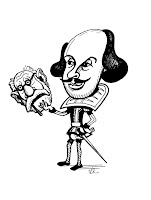ShakespeareReadsFreud.com
Before explaining why this course uses Hamlet to teach psychoanalytic theory and dynamic psychotherapy, let me review a set of experiences. My premise is that one of the major "muscles" a beginning psychotherapist needs to build is tolerance of uncertainty. My worry is that as our field is evolving, this capacity may atrophy. Hamlet has daunted scholars and confused critics for four centuries, so it is sovereign exercise in critical thinking and skepticism. Also it contains varied and lifelike representations of psychopathology and of psychological health. "Shakespeare is a great psychologist," Goethe wrote, "and whatever can be known of the heart of man may be found in his plays." A short, necessary
detour Supremely useful -- and probably impossible to replicate today -- was Continuous Case, a weekly conference in which a resident was supervised in front of the class on an ongoing intensive long-term psychotherapy. Continuous Case was run by a senior analyst who listened to the resident read aloud "process notes," interrupting to criticize the therapy and lead the discussion. The patient, of course, was not present. The senior resident chosen to present the two therapy sessions per class was supposed to be the "most psychoanalytic" of the residents. Also the presenter had to be someone who could accurately capture the therapy in condensed but materially complete notes, the details written up immediately after the patient left the office. Ongoing individual psychotherapy was further demonstrated by means of an Observed Clinical Experience in which a class of trainees and a teacher, all behind a one-way mirror, observed a senior therapist doing weekly long term therapy with a patient. (The patient, by the way, got a reduced fee for the year for participating.) After the therapy hour, the patient was excused and the therapist, the observing teacher behind the mirror, and the class all met to discuss the therapeutic encounter. Almost never were we trainees directly observed treating a patient, and even audiotaping sessions was the exception rather than the rule. That was then, this is
now There is a growing trend toward teaching by means of videos of simulated therapies, with the "patient" played by an actor. The huge advantage here is the ability to show these to larger audiences and via MP4 files on the Internet. Also there is no problem of confidentiality of patient material. And there is standardization and focusing of the lesson being taught -- in other words, everybody is looking at the same "therapy session" -- trainees, supervisors, and experts in various modalities of psychotherapy. So, which situation is
better training -- then or now? One experience that happened again and again was the clash of opinion of observers viewing the same thing at the same time. We came to realize that "reality" on one side of the one-way mirror was rather different from "reality" on the other. Again and again the class and the therapist would disagree on what had "actually happened" in the session. Another experience, even scarier, happened a decade ago with the late Anne Alonso, PhD, the person who was more responsible for my clinical upbringing than anyone else. As an experiment we each took the timed, standardized national examination, the section on psychotherapy. This consisted of 68 multiple choice questions based on five case narratives. Compared with the "correct" answers of the testers, I got 14 answers "wrong," Anne got 19 answers "wrong." Even scarier was that we were more discrepant with each other than the testers -- we disagreed with each other on 22 of the 68 questions. So, this is the field we're in. Two senior clinicians of the same stripe shockingly discordant on an "objective" measure of knowledge of dynamic psychotherapy -- yet, we continued to hope that we did most of our patients good -- and even to believe that many of them were healed. The rationale for
"Psychoanalyzing Hamlet"
-- groves.james@mgh.harvard.edu |
|
